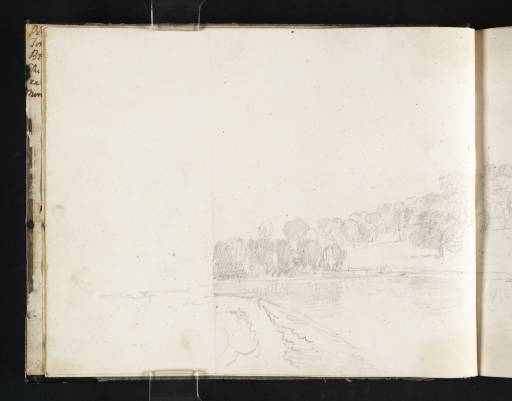Joseph Mallord William Turner Somer Hill 1810
Image 1 of 2
Joseph Mallord William Turner,
Somer Hill
1810
Joseph Mallord William Turner 1775–1851
Folio 3 Verso:
Somer Hill 1810
D10210
Turner Bequest CXXXVII 3a
Turner Bequest CXXXVII 3a
Pencil on white wove paper, 181 x 228 mm
Accepted by the nation as part of the Turner Bequest 1856
References
1909
A.J. Finberg, A Complete Inventory of the Drawings of the Turner Bequest, London 1909, vol.I, p.394, CXXXVII 3a, as ‘Somerhill, near Tunbridge [sic]’.
1974
Martin Butlin, Andrew Wilton and John Gage, Turner 1775–1851, exhibition catalogue, Royal Academy, London 1974, pp.66, 75.
1984
Martin Butlin and Evelyn Joll, The Paintings of J.M.W. Turner, revised ed., New Haven and London 1984, p.83.
2001
Evelyn Joll, ‘Somer-Hill, near Tunbridge, the Seat of W.F. Woodgate, Esq.’, in Evelyn Joll, Martin Butlin and Luke Herrmann eds., The Oxford Companion to J.M.W. Turner, Oxford 2001, p.306.
Turner is likely to have visited Somer Hill, a mile and half south-east of Tonbridge, Kent, during his trip to Sussex to make views for John Fuller following his commission in the spring of 1810 (see Introduction). The house (formerly Summer Hill) was built from 1610 for the 4th Earl of Clanricarde and after changes of ownership now belonged to William Francis Woodgate.
Mainly drawn to the right of a vertical fold in the paper, and continued on folio 4 (D10211), this refined study was used for Somer-Hill, near Tunbridge, The Seat of W.F. Woodgate, Esq. (National Gallery of Scotland, Edinburgh)1 exhibited at the Royal Academy in 1811. The view is from the lake in the grounds, looking roughly eastwards through trees towards the house. Turner made a slightly less finished drawing, presumably preliminary to the version here, in the contemporary Hastings sketchbook (Tate D07725–D07726; Turner Bequest CXI 84a–85) and there is another in the Harvest Home sketchbook (Tate D05375; Turner Bequest LXXXVI 19) from the same time.
It is not known if Woodgate commissioned the picture but it did belong to James Alexander, who bought the estate in 1816 when Woodgate was forced to sell up after the failure of the Tonbridge Bank, which his father had co-founded in 1792. As stated by Butlin and Joll, Alexander may have bought house and picture together or obtained the picture from Turner after acquiring the house.
John Gage has described Somer-Hill as ‘Turner’s masterpiece of naturalism’2 and linked this quality to the artist’s outdoor sketches of the Thames on the basis that these were contemporary rather than up to five years earlier as is now widely accepted. The closest parallels for the treatment of the subject, placing the house in luminous distance beyond a stretch of water, are views of Tabley and Petworth of 1809 and 18103 while Turner has also followed the same practice of making a detailed drawing. Besides being carefully drawn on the spot and serving as working studies in the studio such drawings could be shown to clients for approval and it seems unlikely that Turner would have made either drawing or picture without a prior commission.
David Blayney Brown
March 2011
How to cite
David Blayney Brown, ‘Somer Hill 1810 by Joseph Mallord William Turner’, catalogue entry, March 2011, in David Blayney Brown (ed.), J.M.W. Turner: Sketchbooks, Drawings and Watercolours, Tate Research Publication, December 2012, https://www


